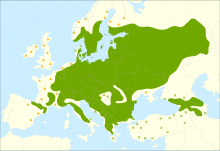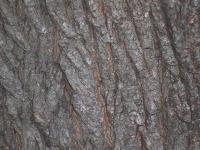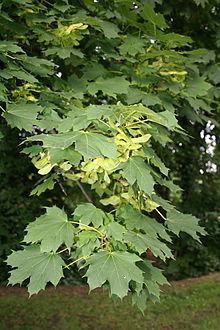Acer platanoides
| Norway maple | |
|---|---|

| |
| Scientific classification | |
| Kingdom: | Plantae |
| Clade: | Tracheophytes |
| Clade: | Angiosperms |
| Clade: | Eudicots |
| Clade: | Rosids |
| Order: | Sapindales |
| Family: | Sapindaceae |
| Genus: | Acer |
| Section: | Acer sect. Platanoidea |
| Species: | A. platanoides
|
| Binomial name | |
| Acer platanoides | |

| |
| Distribution map (native habitat) | |
| Synonyms | |
|
List
| |
Acer platanoides, commonly known as the Norway maple, is a species of maple native to eastern and central Europe and western Asia, from Spain east to Russia, north to southern Scandinavia and southeast to northern Iran.[2][3][4] It was introduced to North America in the mid-1700s as a shade tree.[5] It is a member of the family Sapindaceae.
Description
Acer platanoides is a deciduous tree, growing to 20–30 m (65–100 ft) tall with a trunk up to 1.5 m (5 ft) in diameter, and a broad, rounded crown. The bark is grey-brown and shallowly grooved. Unlike many other maples, mature trees do not tend to develop a shaggy bark. The shoots are green at first, soon becoming pale brown. The winter buds are shiny red-brown.
The

The flowers are in corymbs of 15–30 together, yellow to yellow-green with five sepals and five petals 3–4 mm (1⁄8–3⁄16 in) long; flowering occurs in early spring before the new leaves emerge. The fruit is a double samara with two winged seeds. the seeds are disc-shaped, strongly flattened, 10–15 mm (3⁄8–5⁄8 in) across and 3 mm (1⁄8 in) thick. The wings are 3–5 cm (1+1⁄4–2 in) long, widely spread, approaching a 180° angle. It typically produces a large quantity of viable seeds.
Under ideal conditions in its native range, Norway maple may live up to 250 years, but often has a much shorter life expectancy; in North America, for example, sometimes only 60 years. Especially when used on streets, it can have insufficient space for its root network and is prone to the roots wrapping around themselves, girdling and killing the tree. In addition, their roots tend to be quite shallow and thereby they easily out-compete nearby plants for nutrient uptake.[9] Norway maples often cause significant damage and cleanup costs for municipalities and homeowners when branches break off in storms as it does not have strong wood.[10][11]
Classification and identification


The Norway maple is a member (and is the type species) of the section Platanoidea Pax, characterised by flattened, disc-shaped seeds and the shoots and leaves containing milky sap. Other related species in this section include Acer campestre (field maple), Acer cappadocicum (Cappadocian maple), Acer lobelii (Lobel's maple), and Acer truncatum (Shandong maple). From the field maple, the Norway maple is distinguished by its larger leaves with pointed, not blunt, lobes, and from the other species by the presence of one or more teeth on all of the lobes.[10][11]
It is also frequently confused with the more distantly related Acer saccharum (sugar maple). The sugar maple is easy to differentiate by clear sap in the petiole (leaf stem); Norway maple petioles have white sap.[citation needed] The tips of the points on Norway maple leaves reduce to a fine "hair", while the tips of the points on sugar maple leaves are, on close inspection, rounded. On mature trees, sugar maple bark is more shaggy, while Norway maple bark has small, often criss-crossing grooves.[citation needed] While the shape and angle of leaf lobes vary somewhat within all maple species, the leaf lobes of Norway maple tend to have a more triangular (acuminate) shape, in contrast to the more finely toothed lobes of sugar maples, that narrow towards the base.[12]: 397 Flowering and seed production begins at ten years of age, however large quantities of seeds are not produced until the tree is 20. As with most maples, Norway maple is normally dioecious (separate male and female trees), occasionally monoecious, and trees may change gender from year to year.[citation needed]
The fruits of Norway maple are paired samaras with widely diverging wings,[12]: 395 distinguishing them from those of sycamore, Acer pseudoplatanus which are at 90 degrees to each other.[12] Norway maple seeds are flattened, while those of sugar maple are globose.[citation needed] The sugar maple usually has a brighter orange autumn color, where the Norway maple is usually yellow, although some of the red-leaved cultivars appear more orange.
The flowers emerge in spring before the leaves and last 2-3 weeks. Leafout of Norway maple occurs roughly when air temperatures reach 55°F (12°C) and there is at least 13 hours of daylight. Leaf drop in autumn is initiated when day lengths fall to approximately 10 hours. Depending on the latitude, leaf drop may vary by as much as three weeks, beginning in the second week of October in Scandinavia and the first week of November in southern Europe. Unlike some other maples that wait for the soil to warm up, A. platanoides seeds require only three months of exposure to temperatures lower than 4 °C (40 °F) and will sprout in early spring, around the same time that leafout begins. Norway maple does not require freezing temperatures for proper growth, however it is adapted to higher latitudes with long summer days and does not perform well when planted south of the 37th parallel, the approximate southern limit of its range in Europe. Further, most North American Norway maples are believed descended from stock brought from Germany, at approximately 48N to 54N, not the more southerly ecotypes found in Italy and the Balkans that evolved for similar lighting conditions as the continental United States. The heavy seed crop and high germination rate contributes to its invasiveness in North America, where it forms dense monotypic stands that choke out native vegetation. The tree is also capable of growing in low lighting conditions within a forest canopy, leafs out earlier than most North American maple species, and its growing season tends to run longer as the lighting conditions of the United States (see above) result in fall dormancy occurring later than it does in the higher latitude of Europe. It is one of the few introduced species that can successfully invade and colonize a virgin forest. By comparison, in its native range, Norway maple is rarely a dominant species and instead occurs mostly as a scattered understory tree.[10][11]
Cultivation and uses

The wood is hard, yellowish-white to pale reddish, with the heartwood not distinct; it is used for furniture and woodturning.[13] Norway maple sits ambiguously between hard and soft maple with a Janka hardness of 1,010 lbf or 4,500 N. The wood is rated as non-durable to perishable in regard to decay resistance.[14] In Europe, it is used for furniture, flooring and musical instruments. This species as grown in the former Yugoslavia is also called Bosnian maple and is probably the maple used by the Italian violin makers Stradivari and Guarneri.
Norway maple has been widely taken into cultivation in other areas, including western Europe northwest of its native range. It grows north of the
It is favored due to its tall trunk and tolerance of poor, compacted
Cultivars
Many cultivars have been selected for distinctive leaf shapes or colorations, such as the dark purple of 'Crimson King' and 'Schwedleri', the variegated leaves of 'Drummondii', the light green of 'Emerald Queen', and the deeply divided, feathery leaves of 'Dissectum' and 'Lorbergii'. The purple-foliage cultivars have orange to red autumn colour. 'Columnare' is selected for its narrow upright growth.[11][20] The cultivars 'Crimson King'[21] and 'Prigold' (Princeton Gold)[22] have gained the Royal Horticultural Society's Award of Garden Merit.
As an invasive species in North America

The Norway maple was introduced to northeastern North America between 1750 and 1760 as an ornamental shade tree. It was brought to the Pacific Northwest in the 1870s.
-
Fruit (samara): note the flat seed capsule and the angle of the "wings"
-
Typical yellow fall foliage
-
Atypical orange-red fall colour
-
Purple leaves of cultivar 'Schwedleri'
-
Twig and buds
Natural enemies
The larvae of a number of species of
References
- . Retrieved 12 November 2021.
- ^ BSBI List 2007 (xls). Botanical Society of Britain and Ireland. Archived from the original (xls) on 2015-06-26. Retrieved 2014-10-17.
- ^ Flora Europaea: Acer platanoides distribution
- ^ Den virtuella floran: Acer platanoides distribution
- ^ a b Love, R (2003). "Introduced Species Summary Project: Norway maple (Acer platanoides)". Columbia University. Archived from the original on 2016-08-21. Retrieved 27 August 2018.
- ^ "Introduced Species Summary Project: Norway Maple (Acer platanoides)". Archived from the original on 2018-09-09. Retrieved September 30, 2018.
- ^ "Acer platanoides". Retrieved September 30, 2018.
- ^ "Acer platanoides". Retrieved September 30, 2018.
- ^ "Norway Maple (Acer platanoides)". www.devostree.ca. Feb 12, 2018. Retrieved June 6, 2018.
- ^ ISBN 978-0-00-220013-4.
- ^ ISBN 978-0-00-212035-7.
- ^ ISBN 9781527226302.
- ISBN 978-0-416-61780-1.
- ^ "Differences Between Hard Maple and Soft Maple, The Wood Database".
- ^ "Trees Near Their Limits – Alaska".
- ^ "Norway Maple (Acer platanoides)". 10 June 2021.
- ^ History and Range of Norway Maple
- ^ D'Cruz, Mark. "Ma-Ke Bonsai Care Guide for Acer platanoides". Ma-Ke Bonsai. Archived from the original on 14 July 2011. Retrieved 2011-07-05.
- ^ "North American Maple Syrup Producers Manual". The Ohio State University College of Food, Agricultural, and Environmental Sciences. Retrieved 27 August 2018.
- ISBN 978-0-333-47494-5.
- ^ "RHS Plant Selector – Acer platanoides 'Crimson King'". Retrieved 23 February 2020.
- ^ "Acer platanoides Princeton Gold='Prigo' (PBR)". Retrieved 29 December 2017.
- ^ .
- ^ "Controlling Invasive Plants" (PDF).
- S2CID 45919084. Archived from the original(PDF) on 2010-07-10.
- ^ Swearingen, J.; Reshetiloff, K.; Slattery, B.; Zwicker, S. (2002). "Norway Maple". Plant Invaders of Mid-Atlantic Natural Areas. National Park Service and U.S. Fish & Wildlife Service. Archived from the original on 2003-03-17.
- ^ "Invasive Species". New Hampshire Dept. of Agriculture. Archived from the original on 7 November 2012. Retrieved 22 October 2013.
- ^ "Massachusetts Prohibited Plant List". Mass.gov. 2017. Retrieved 28 August 2018.
- ^ "Interim List of Invasive Plant Species in New York State". Advisory Invasive Plant List. New York State Department of Environmental Conservation. Archived from the original on 12 May 2013. Retrieved 1 June 2013.
- ISBN 0-333-49493-8.
- ISBN 9780691028736.
- ^ Plant Galls Archived 2013-10-29 at the Wayback Machine Retrieved : 2013-07-10
External links
- Acer platanoides - information, genetic conservation units and related resources. European Forest Genetic Resources Programme (EUFORGEN)
- Portrait of the Earth: Acer platanoides (Norway maple) — with winter images.









